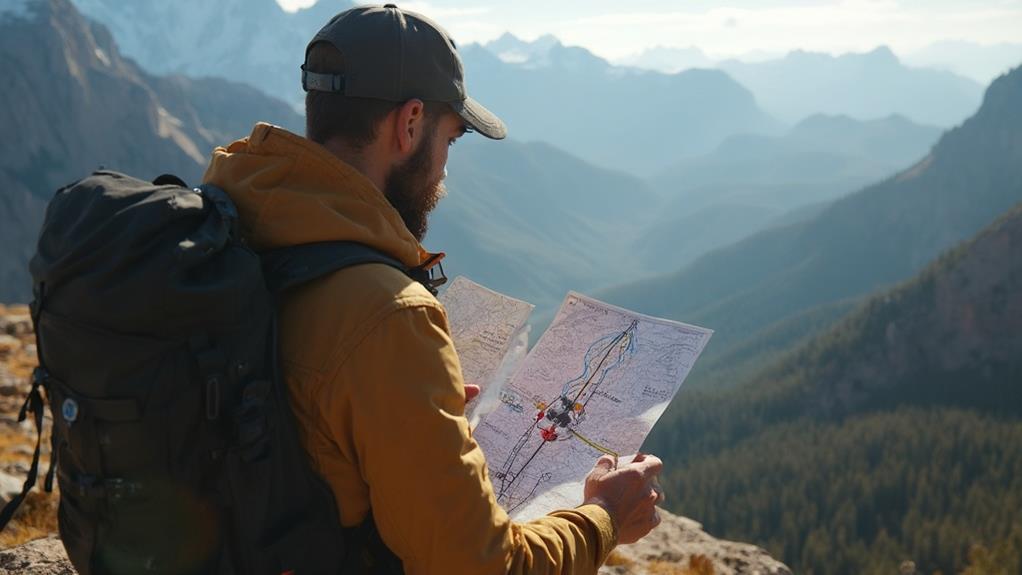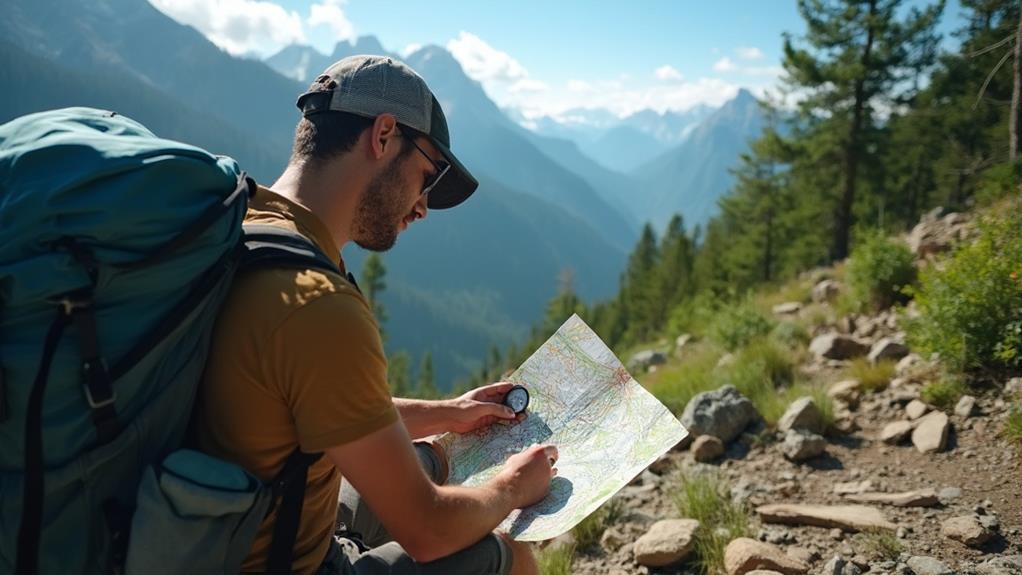Mastering the art of navigation with a map and compass is vital for advanced hiking. It guarantees precision and safety in challenging terrains. A compass, unaffected by external conditions, provides magnetic north. Understanding its components—baseplate, needle, bezel—is significant. Accurate bearing calculation requires alignment with true north, incorporating magnetic declination variations. Triangulation enhances positional accuracy by intersecting bearings from known landmarks. Regular practice with dead reckoning and landmark identification fortifies navigation skills in poor visibility. A thorough grasp of these techniques not only prevents disorientation but also provides a reliable navigation framework for the advanced hiker seeking deeper insights.
Key Takeaways
- Understanding and adjusting for magnetic declination ensures accurate navigation by aligning map readings with true north.
- Regular practice with a compass and topographic maps enhances confidence and proficiency in navigating diverse terrains.
- Triangulation using landmarks helps pinpoint your location by intersecting bearing lines on the map.
- Accurate map alignment with true north is crucial for successful compass navigation and route planning.
- Taking accurate bearings involves aligning the compass with the map and adjusting for magnetic variations.
Importance of Compass Navigation
In the domain of advanced hiking, the importance of compass navigation cannot be overstated. Historically, the compass has been a steadfast tool, tracing its origins back to ancient China. Despite the plethora of modern navigation technologies, the compass remains indispensable due to its simplicity and reliability. Myths surrounding navigation often suggest that digital devices can replace traditional tools; however, they are susceptible to battery depletion and signal loss. Conversely, compasses are not subject to such limitations, functioning efficiently in diverse environmental conditions.
Compass navigation is essential for guaranteeing outdoor safety and self-reliance, particularly in emergency scenarios. Its durability and independence from electronic failure make it an important navigational aid in remote terrains. Mastery of compass skills allows hikers to traverse challenging landscapes, even under compromised visibility, such as dense forests or heavy fog.
Regular practice with a compass, complemented by topographic maps, not only boosts navigational confidence but also prepares hikers for more adventurous, off-trail expeditions. This proficiency guarantees that outdoor enthusiasts can effectively engage with nature, reducing reliance on uncertain electronic devices and enhancing their ability to navigate successfully in the vast, unpredictable wilderness.
Understanding Compass Components

While mastering compass navigation is fundamental to advanced hiking, a thorough understanding of compass components is equally vital for effective use. At the heart of any compass is the magnetized needle, which aligns with Earth's magnetic field, pointing towards magnetic north. This is distinct from true north, necessitating an understanding of declination adjustments. The baseplate, often transparent, facilitates map visibility and aids triangulation by aligning with mapped landmarks.
Key components of a compass include:
| Component | Functionality |
|---|---|
| Baseplate | Guarantees map visibility and aids in triangulation |
| Direction of Travel Arrow | Indicates the desired navigation path |
| Rotating Bezel | Displays 0 to 360 degrees for setting specific bearings |
| Index Line | Used for accurate bearing measurements |
To maintain precision, compass maintenance is essential. Regular checks guarantee the magnetized needle's sensitivity and the bezel's rotational accuracy. Compass accessories, such as declination adjustment tools, enhance usability by allowing for precise alignment with magnetic north. Understanding these components and their roles enables hikers to navigate confidently, guaranteeing safe and efficient travel across varied terrains. This knowledge not only enhances navigation skills but also ensures that the compass remains a reliable tool for exploration.
Types of Compasses
Navigational proficiency hinges upon the selection of an appropriate compass type tailored to the hiker's specific needs and environmental conditions. Among the compass types, the baseplate compass stands out for its utility in orienteering and general hiking. It features a transparent baseplate, which facilitates map interaction and enhances triangulation accuracy.
This compass type is recommended for beginners due to its straightforward design and essential compass features.
For advanced navigation requiring precision, the lensatic compass is preferred. Equipped with a sighting mirror and a clinometer, it is engineered for tasks demanding meticulous angle measurement and directional accuracy.
Its complex structure supports navigation in challenging terrains, making it a choice for experienced hikers.
Button compasses, though limited in advanced compass features, offer compactness and ease for quick directional assessments. However, their simplicity may restrict precise navigation.
Military-style compasses are constructed for resilience, incorporating robust materials to withstand extreme conditions. This compass type often includes additional navigation tools, ensuring reliability in diverse geographic scenarios.
It is imperative to avoid magnetic interference by steering clear of metal objects during usage, as this can skew the magnetized needle, compromising navigational precision.
Basic Compass Navigation Techniques

A compass needle serves as a steadfast guide, consistently pointing toward magnetic north, which is important for precise navigation. However, it's important to dispel compass myths, such as the misconception that compasses point to true north. Instead, understanding magnetic declination—the angle difference between magnetic north and true north—is critical for accurate navigation. Ignoring declination can lead to significant navigation mistakes, especially in regions where the declination is substantial.
To effectively employ a compass, one should begin by orienting the map. Align the compass dial to north at the index mark, ensuring the compass edge aligns with the map's vertical gridlines. Turn your body until the red end of the needle is within the red shed, synchronizing the map with the terrain.
Familiarity with compass features, such as the rotating bezel and direction of travel arrow, is essential. These enable precise alignment with your intended route.
Regular practice, such as adjusting for declination and confirming your course, enhances navigational proficiency across varied terrains. Mastering these basic techniques mitigates common navigation mistakes and builds foundational skills for more advanced navigational tasks.
Taking Accurate Bearings
Understanding how to take accurate bearings is an essential skill for advanced hiking navigation, requiring precise alignment of the compass and map. To execute bearing techniques proficiently, begin by positioning the compass edge along the line from your current location to your desired destination on the map. Verify the direction of travel arrow aligns toward the target.
Next, rotate the compass dial until the orienting lines are parallel with the map's north-south grid lines, enabling precise alignment with true north. The bearing is then read from the index line, offering a numerical value critical for navigation.
In field practice, this process shifts slightly. The compass should be held flat in hand, guaranteeing stability. Rotate your body, not the compass, until the magnetic needle aligns with the red shed, indicating that the compass is correctly oriented with magnetic north.
This physical confirmation is pivotal in confirming that you face the intended direction. Regular practice in diverse terrains is recommended to fortify familiarity with these bearing techniques. Such practice enhances the ability to respond adeptly to environmental variations, consequently refining overall navigation accuracy during advanced hiking endeavors.
Declination and Adjustments

While often overlooked by novice adventurers, declination is a critical factor in ensuring precise navigation during advanced hiking excursions. Declination refers to the angular difference between true north and magnetic north. This discrepancy is not static; it exhibits declination variations across different geographical locations and can alter over time. Consequently, reliance on declination updates through current maps is indispensable for accurate navigation. Topographic maps usually include a declination diagram, displaying the declination for a specific region in degrees east or west.
| Declination Type | Adjustment Method |
|---|---|
| West Declination | Add to magnetic bearing |
| East Declination | Subtract from magnetic bearing |
Failing to account for these adjustments can culminate in substantial navigational errors, particularly over protracted distances, potentially leading to deviations spanning hundreds of meters off-course. This makes it paramount for hikers to meticulously apply the correct declination adjustments when deriving bearings. Additionally, it is essential to regularly check and update declination adjustments, reflecting the latest geographical data. By doing so, hikers fortify their navigation acumen, mitigating the risk of inaccuracies in the field. Therefore, understanding and applying declination adjustments is an essential skill for any seasoned hiker aiming to master advanced navigation techniques.
Map Orientation Skills

Map orientation is a critical skill that requires the precise alignment of the map's north with the compass's north arrow, ensuring both correspond accurately to the physical environment.
This process necessitates the adjustment for magnetic declination, which involves referencing the map's declination key to rectify the angular disparity between true north and magnetic north.
Aligning Map With Compass
Aligning a map with a compass is an essential skill for advanced hiking, ensuring precise direction and orientation in the wilderness. It begins with compass alignment, where the north arrow of the compass dial is aligned to the index line, and the compass edge is matched with the map's north-south gridlines. This establishes a baseline for accurate direction.
Next, landmark identification aids in confirming your position. By positioning the compass edge between two prominent landmarks visible both on the map and in the terrain, one can effectively cross-reference locations, ensuring that the map and compass are synchronized to magnetic north.
As you turn your body, align the compass needle with the red shed (the red housing) to confirm both the map and compass are oriented correctly. This method allows hikers to maintain an accurate bearing, essential for traversing complex terrains.
Continual practice of these map orientation techniques across varied environments enhances proficiency. While aligning the map and compass, always be mindful of regional magnetic declination adjustments, ensuring that the alignment reflects true geographic orientation.
This rigorous approach to direction fosters confidence and precision, critical for safely exploring and mastering advanced hiking trails.
Adjusting for Magnetic Declination
The intricacies of magnetic declination adjustment are fundamental to precise map orientation skills in advanced hiking. Understanding declination effects is vital because magnetic north, indicated by the compass, diverges from true north due to Earth's magnetic field variations.
These variations differ geographically and temporally, necessitating regular compass calibration and assessment of current declination values. Without this consideration, navigation errors can occur, especially in isolated terrains where accuracy is imperative for safety.
To effectively adjust for magnetic declination, hikers should follow a systematic approach:
- Consult the Declination Diagram: First, examine the declination diagram on your map. This diagram provides the specific angle of declination for your location, indicating whether to add or subtract from your compass bearing.
- Apply Declination to Compass Readings: For instance, with a 10-degree east declination, add 10 degrees to the compass reading to align with true north. Conversely, subtract 5 degrees for a 5-degree west declination.
- Regularly Update Declination Information: As local geological shifts and magnetic anomalies can alter compass accuracy, it's important to consistently update declination data, especially when exploring new regions.
Accurate declination adjustment guarantees reliable navigation, safeguarding hikers against potential disorientation.
Triangulation for Positioning

Triangulation for precise positioning begins with the identification of key geographical landmarks that are distinctly recognizable and prominently featured on your topographic map.
Ensuring accurate map alignment with true north is imperative, necessitating adjustments for any local magnetic declination to maintain the integrity of the bearings you calculate.
Identifying Key Landmarks
To effectively employ triangulation for precise positioning during advanced hiking, a fundamental step involves identifying key landmarks within your surroundings.
Landmark selection is critical, as these must be distinct and recognizable features both in the terrain and on your map. Visibility plays a key role; select landmarks that are clearly visible and unobstructed within your line of sight. For successful triangulation, guarantee these landmarks are widespread enough to create an accurate bearing intersection.
To execute triangulation:
- Identify and Sight Landmarks: Select at least two prominent landmarks visible in your environment that correspond to features on your topographical map.
- Take Bearings: Use your compass to take a bearing on each landmark by aligning the direction of travel arrow with the landmark. Record the compass degree at the index line for each landmark.
- Map and Adjust: Mark these bearings on your map, adjusting for magnetic declination to guarantee accuracy. Draw lines from each landmark on the map where the bearings intersect, indicating your approximate position.
Accurate Map Alignment
Accurate map alignment, a cornerstone of successful navigation, requires a nuanced understanding of both geographic features and compass use. To commence triangulation for positioning, the map must be aligned with true north. This involves matching the compass's magnetic needle with the map's north indicator, while adjusting for any local declination to mitigate map distortion. This initial alignment guarantees that all subsequent bearings and positions are based on a true geographic framework.
Once the map is accurately oriented, identifying prominent terrain features is essential. Select at least two easily recognizable landmarks within your vicinity. Using a compass, take precise bearings toward each landmark. The utilization of a lensatic compass is recommended, particularly when landmarks are distant, due to its superior accuracy in sighting and reading. By drawing lines from each landmark on the map according to the bearings, the intersection of these lines reveals your approximate location.
Practicing triangulation techniques across varying terrains enhances navigational skills, allowing hikers to adeptly manage and interpret map distortion and terrain features.
Mastery of accurate map alignment not only guarantees safe navigation but also enriches the overall hiking experience by fostering confidence and preparedness.
Calculating Bearing Intersections
Establishing your precise location in unfamiliar territory hinges on the meticulous process of calculating bearing intersections, a fundamental aspect of triangulation. This technique requires identifying at least two known landmarks and accurately measuring the bearing to each using a compass.
To guarantee bearing accuracy, it is essential that the map is correctly oriented; true north must align with the compass's magnetic north, taking into account local magnetic declination.
Once bearings are established, employ intersection techniques by drawing directional lines on the map from each landmark. The intersection of these lines pinpoints your approximate position. Precision in both bearing measurement and line drawing is vital, as even minor inaccuracies can result in significant positional errors.
Consider the following steps for effective triangulation:
- Identify and Take Bearings: Select at least two distant and identifiable landmarks and record the bearings with precision.
- Align and Adjust: Correctly orient your map by adjusting for magnetic declination to guarantee accurate line drawing.
- Draw and Intersect: Draw lines from each landmark according to the measured bearings. The intersection of these lines marks your location.
Regular practice of these intersection techniques in diverse terrains will enhance your proficiency and confidence in navigation using map and compass.
Enhancing Navigation Proficiency

Mastering navigation proficiency necessitates a thorough understanding of both analog and digital navigation tools, which are indispensable for traversing diverse terrains. Achieving navigational confidence requires regular practice with compasses and topographic maps.
These exercises should focus on understanding the intricacies of compass components, such as the baseplate, rotating bezel, and the direction of travel arrow, which are essential for orienting maps and obtaining precise bearings.
Critical to this competency is the ability to adjust for magnetic declination, a factor that varies by geographic location and evolves over time. Accurate navigation hinges on this adjustment, as it guarantees that the compass readings align with true north rather than magnetic north.
Outdoor workshops facilitated by local clubs provide valuable opportunities for enhancing these skills. These workshops deliver hands-on experience under expert guidance, thereby solidifying theoretical knowledge through practical application.
Incorporating digital mapping tools alongside traditional methods offers a thorough approach to navigation. This synergy allows for effective route planning and adaptability in the field, guaranteeing preparedness for unexpected topographical challenges.
Overcoming Navigation Challenges

Maneuvering through environments with poor visibility, such as fog or darkness, necessitates the application of dead reckoning techniques, which utilize calculations of speed and elapsed time to estimate current position from a last known reference point.
In contrast, traversing complex terrains like mountainous regions or dense forests can be efficiently managed through landmark navigation, leveraging prominent geographic features as directional aids.
Mastery of these techniques is essential for hikers aiming to maintain accuracy and confidence in challenging conditions, ensuring safe and effective route planning regardless of environmental obstacles.
Techniques for Poor Visibility
Infrequently faced yet fundamentally challenging, poor visibility conditions demand a strategic approach to maintain accurate navigation on advanced hiking trails. Addressing visibility challenges requires adept use of navigation tools, such as a compass and map, to preserve orientation and trajectory. A basic technique involves using a compass to establish a precise bearing. Align the compass with the map, setting the direction of travel arrow toward the target, guaranteeing a consistent course despite limited visibility.
To further enhance navigation, consider employing the following techniques:
- Dead Reckoning: This method estimates your position based on known speed and elapsed time, facilitating continuous navigation without visible landmarks.
- Catchline Navigation: Utilize long, linear geographic features like rivers or roads as reliable guides, reducing dependency on visual endpoints.
- Map-Compass Checks: Regularly align your map with the compass to prevent disorientation and maintain accurate course adjustments.
Prior familiarity with terrain features and landmarks can greatly improve navigation confidence. Recalling these details offers mental reference points, vital when visual cues are obscured.
These strategies collectively mitigate the risks posed by poor visibility, enabling safe and effective navigation through challenging environments.
Navigating Complex Terrain
Confronting the complexities of advanced hiking terrain necessitates a robust understanding of geographic navigation principles. Maneuvering complex terrain features, such as mountainous regions or dense forests, presents unique terrain challenges that demand precision and adaptability. Poor visibility conditions, including fog or rain, can obscure landmarks, making it imperative to frequently verify compass bearings and map orientation. This guarantees alignment with predetermined routes, minimizing the risk of deviation from the intended path.
Mastery of dead reckoning and landmark navigation techniques is essential in these environments. Dead reckoning involves calculating one's current position by using a previously determined position, accounting for known speeds, elapsed time, and course direction. This method, coupled with identifying and using prominent terrain features as landmarks, enhances navigational accuracy in the absence of technological aids. The potential for GPS malfunctions underscores the necessity of traditional navigation skills, emphasizing redundancy and self-reliance in navigation strategies.
Moreover, disorientation due to fatigue or stress can exacerbate navigation errors in challenging terrains. Regular breaks and periodic reassessment of the surroundings are vital to maintain situational awareness.
Additionally, unexpected wildlife encounters necessitate a composed response, utilizing compass skills to navigate safely back to familiar paths, thereby mitigating safety risks.
Resources for Further Learning

For those seeking to refine their navigation skills in advanced hiking, a wealth of resources is available to bolster both theoretical understanding and practical application. Online tutorials provide step-by-step guidance on utilizing both analog and digital compasses, enabling users to enhance their proficiency in navigation.
These resources often include interactive elements designed to simulate real-life scenarios, thereby bridging the gap between theoretical knowledge and field application. In addition to these, community forums serve as dynamic platforms where experienced hikers share insights, tips, and personal experiences, fostering a collaborative learning environment that enriches one's navigational expertise.
To further augment one's skills, consider the following resources:
- Workshops by Local Outdoor Clubs: These events offer practical, hands-on navigation training under the guidance of seasoned hikers, providing invaluable field experience.
- Comprehensive Books and Guides: Publications dedicated to wilderness navigation explore intricate techniques and strategies, offering a detailed analysis of map and compass usage.
- Smartphone Apps: Applications like Digital Field Compass can complement traditional methods, although it is vital to verify proper calibration for precision in geographic orientation.
Frequently Asked Questions
How to Use Map and Compass for Hiking?
To effectively use a map and compass while hiking, orient the map to true north, account for magnetic declination, identify terrain features, take accurate bearings, and employ triangulation with visible landmarks for precise geographic positioning and navigation.
How Can I Navigate With a Map and a Compass?
To navigate with a map and compass, utilize navigational techniques such as compass reading, orienting the map to magnetic north, accounting for magnetic declination, and employing triangulation with known landmarks for precise geographic positioning in varied terrains.
How Do You Orienteer With a Map and Compass?
To effectively orienteer with a map and compass, one must master map reading and compass skills. This involves aligning the map with true north, calculating declination, taking accurate bearings, and utilizing triangulation for precise geographic positioning.
What Is the Best Type of Map for Hiking?
Topographic maps are ideal for hiking due to their detailed representation of terrain features, elevation gain, and map symbols essential for effective route planning. Digital maps supplement this by offering interactive map reading and real-time updates on hiking trails.
Conclusion
Mastering map and compass navigation is essential for advanced hiking, offering precision and reliability in diverse terrains. Understanding compass components and types enhances proficiency in taking accurate bearings and executing triangulation for precise positioning. Developing advanced techniques and addressing navigation challenges are vital for ensuring safety and efficiency. Continuous learning through specialized resources further refines skills, fostering an all-encompassing understanding of geographic navigation principles. Rigorous practice and theoretical knowledge integration are imperative for proficient and confident navigation in complex environments.